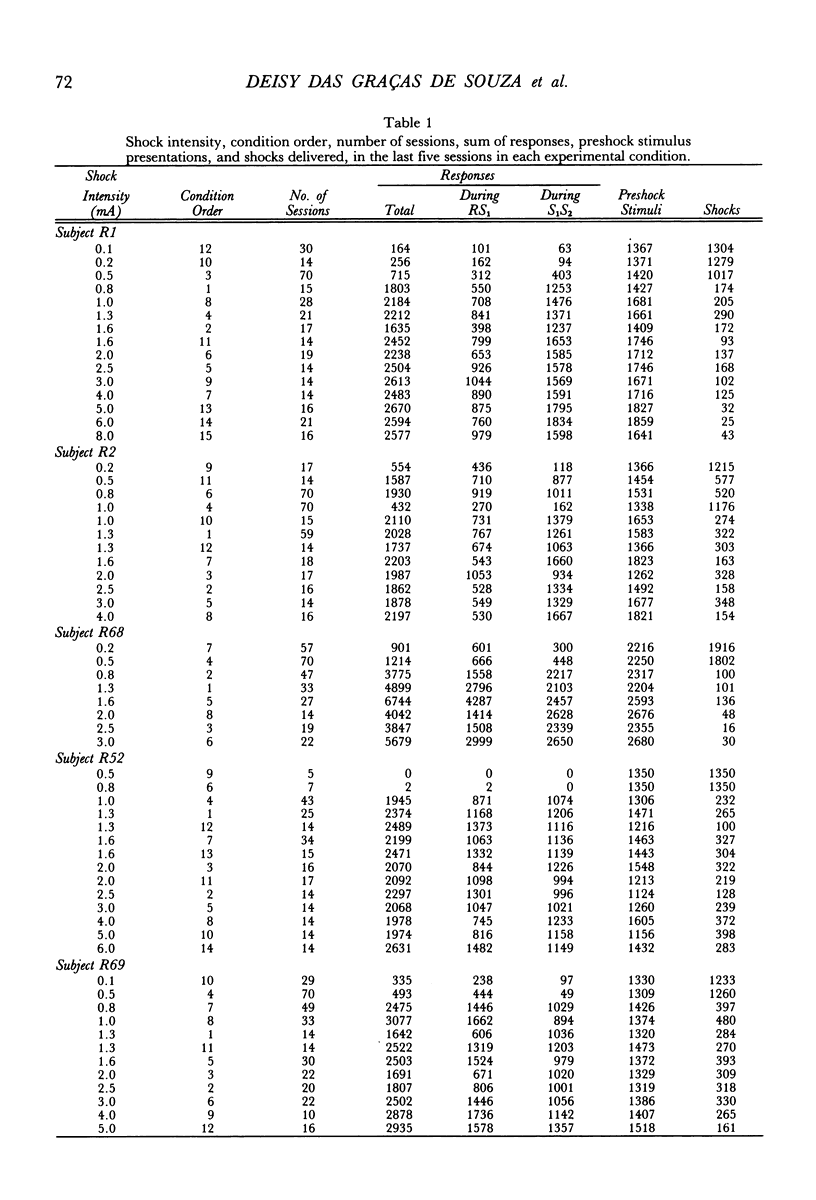Abstract
Five rats were submitted to a signaled free-operant avoidance contingency. Throughout the experiment, shock intensity was varied from 0.1 to 8.0 mA, with shock duration constant at 200 milleseconds. Results indicate: (a) an all-or-none effect of shock intensity on response and shock rates, on percentage of shocks avoided, and on frequency of occurrence of responding during the preshock stimulus; and (b) no systematic effect of shock intensity on stimulus control, measured either by the percentage of stimulus presentations accompanied by a response or by the percentage of responses that occurred during those preshock stimuli. Such results indicate that for each subject there is a minimum shock intensity necessary to establish and maintain avoidance responding; intensities higher than this minimum value have little or no effect on responding (with an upper limit for those strong intensities with a general disruptive effect on behavior).
Keywords: signaled free-operant avoidance, shock intensity, bar press, rats
Full text
PDF







Selected References
These references are in PubMed. This may not be the complete list of references from this article.
- BOREN J. J., SIDMAN M., HERRNSTEIN R. J. Avoidance, escape, and extinction as functions of shock intensity. J Comp Physiol Psychol. 1959 Aug;52:420–426. doi: 10.1037/h0042727. [DOI] [PubMed] [Google Scholar]
- CATANIA A. C. Concurrent performances: a baseline for the study of reinforcement magnitude. J Exp Anal Behav. 1963 Apr;6:299–300. doi: 10.1901/jeab.1963.6-299. [DOI] [PMC free article] [PubMed] [Google Scholar]
- D'Amato M. R., Fazzaro J., Etkin M. Discriminated bar-press avoidance maintenance and extinction in rats as a function of shock intensity. J Comp Physiol Psychol. 1967 Apr;63(2):351–354. doi: 10.1037/h0024386. [DOI] [PubMed] [Google Scholar]
- De Moraes A. B., Todorov J. C. Signalled free-operant avoidance of shock by pigeons pecking a key. J Exp Anal Behav. 1977 Mar;27(2):281–291. doi: 10.1901/jeab.1977.27-281. [DOI] [PMC free article] [PubMed] [Google Scholar]
- Dunn R. M. Choice, relative reinforcer duration, and the changeover ratio. J Exp Anal Behav. 1982 Nov;38(3):313–319. doi: 10.1901/jeab.1982.38-313. [DOI] [PMC free article] [PubMed] [Google Scholar]
- Ferrari E. A., Todorov J. C., Graeff F. G. Nondiscriminated avoidance of shock by pigeons pecking a key. J Exp Anal Behav. 1973 Mar;19(2):211–218. doi: 10.1901/jeab.1973.19-211. [DOI] [PMC free article] [PubMed] [Google Scholar]
- Harsh J., Badia P. Choice for signalled over unsignalled shock as a function of shock intensity. J Exp Anal Behav. 1975 May;23(3):349–355. doi: 10.1901/jeab.1975.23-349. [DOI] [PMC free article] [PubMed] [Google Scholar]
- Keller J. V., Gollub L. R. Duration and rate of reinforcement as determinants of concurrent responding. J Exp Anal Behav. 1977 Sep;28(2):145–153. doi: 10.1901/jeab.1977.28-145. [DOI] [PMC free article] [PubMed] [Google Scholar]
- Klein M., Rilling M. Effects of response-shock interval and shock intensity on free-operant avoidance responding in the pigeon. J Exp Anal Behav. 1972 Sep;18(2):295–303. doi: 10.1901/jeab.1972.18-295. [DOI] [PMC free article] [PubMed] [Google Scholar]
- Leander J. D. Shock intensity and duration interactions on free-operant avoidance behavior. J Exp Anal Behav. 1973 May;19(3):481–490. doi: 10.1901/jeab.1973.19-481. [DOI] [PMC free article] [PubMed] [Google Scholar]
- Pomerleau O. F. The effect of stimuli followed by response-independent shock on shock-avoidance behavior. J Exp Anal Behav. 1970 Jul;14(1):11–21. doi: 10.1901/jeab.1970.14-11. [DOI] [PMC free article] [PubMed] [Google Scholar]
- Powell R. W. The effect of shock intensity upon responding under a multiple-avoidance schedule. J Exp Anal Behav. 1970 Nov;14(3):321–329. doi: 10.1901/jeab.1970.14-321. [DOI] [PMC free article] [PubMed] [Google Scholar]
- Riess D. Sidman avoidance in rats as a function of shock intensity and duration. J Comp Physiol Psychol. 1970 Dec;73(3):481–485. doi: 10.1037/h0030235. [DOI] [PubMed] [Google Scholar]
- SIDMAN M. Some properties of the warning stimulus in avoidance behavior. J Comp Physiol Psychol. 1955 Dec;48(6):444–450. doi: 10.1037/h0047481. [DOI] [PubMed] [Google Scholar]
- Schneider J. W. Reinforcer effectiveness as a function of reinforcer rate and magnitude: a comparison of concurrent performances. J Exp Anal Behav. 1973 Nov;20(3):461–471. doi: 10.1901/jeab.1973.20-461. [DOI] [PMC free article] [PubMed] [Google Scholar]
- Todorov J. C., Hanna E. S., Bittencourt De Sá M. C. Frequency versus magnitude of reinforcement: New data with a different procedure. J Exp Anal Behav. 1984 Mar;41(2):157–167. doi: 10.1901/jeab.1984.41-157. [DOI] [PMC free article] [PubMed] [Google Scholar]
- Todorov J. C. Interaction of frequency and magnitude of reinforcement on concurrent performances. J Exp Anal Behav. 1973 May;19(3):451–458. doi: 10.1901/jeab.1973.19-451. [DOI] [PMC free article] [PubMed] [Google Scholar]
- ULRICH R. E., HOLZ W. C., AZRIN N. H. STIMULUS CONTROL OF AVOIDANCE BEHAVIOR. J Exp Anal Behav. 1964 Mar;7:129–133. doi: 10.1901/jeab.1964.7-129. [DOI] [PMC free article] [PubMed] [Google Scholar]


